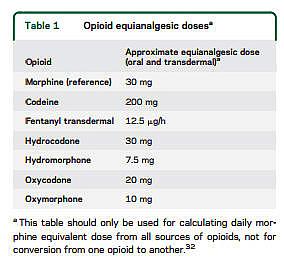Pain docs warn against opiods

(Photo courtesy of Joshua McKenna/Flickr)
When the doctors who are charged with managing pain come out with a public policy position against use of opioids (like oxycodone, methodone and hydrocodine) for chronic pain, we should pay attention.
The American Academy of Neurology (AAN) released a position statement in December 2014 to tell the world that chronic use of opioids provides “no substantial evidence for maintenance of pain relief or improved function over long periods of time (over 3 months) without incurring serious risk of overdose, dependence, or addiction.”
In this policy statement, the Academy finds that the effectiveness of opioids for chronic non-cancer pain is “modest” and the effect on function “small.” The Academy acknowledges that in some cases the need for immediate pain relief is clear. However, the few studies on long-term pain management that the Academy found conclude that alternatives to drug therapy such ascognitive behavioral therapy and activity coaching are as effective at managing pain and probably better at improving functionality without the side effects and risks of medications.
The side effects alone are a good reason to avoid opioids: Constipation, nausea and vomiting, dizziness and drowsiness are commonly reported.
Long-Term Effects Observed But Not Studied
The long-term effects have not been seen in studies because the studies are too short. So the Academy looked to observational and epidemiologic investigations which have found a laundry list of long-term implications including inhibition of endogenous sex hormone production (lowering hormone production), hypogonadism (body stops producing sex hormones), infertility, immunosuppression (keeps the immune system from working), falls and fractures in elders, neonatal abstinence syndrome (withdrawal from opioids in newborns), cardiac issues, sleep-disordered breathing (opioids depress breathing), opioid-induced hyperalgesia (increased sensitivity to pain), nonfatal overdose hospitalization (7 for every death according to one study), ER visits and death from unintentional overdosing.
Opioid-related deaths constitute a “national epidemic and public health emergency,” according to the Academy. More Americans died from unintentional opioid overdose from 1999 to 2010 than all the Americans who died in the Vietnam War.
If you think this doesn’t apply to you, consider this: “50% of patients taking opioids for at least 3 months are still on opioids 5 years later.”
Table courtesy AAN.
In a study of low-back injured workers were 2x more likely to end up on long-term disability if given opioids soon after the accident. This suggests (to me) that using opioids on acute/subacute pain can lead to the pain being reclassified into chronic pain. Why? Perhaps because the pain was alleviated in the short term the workers did not get the physical therapy or other treatment needed to cure the problem. Perhaps opioid use turned into physical dependence and addiction. The actual reasons are unknown — they were not part of the study. What is certain is that the Academy policy states, “It seems likely, in the long run, the use of opioids chronically for most routine conditions, such as chronic low back pain, chronic headaches or fibromyalgia, will not prove to be worth the risk.
The AAN Policy Statement paints a picture of a drug that is difficult to stop using, has killed thousands of people a year, can leave survivors with damaging side effects and offers precious little proof that it is the best pain option or even a good pain option.
If Your Doctor Prescribes Opioids
Consider refusing them: they are not recommended for headaches or migraines, and the benefits of using them for fibromyalgia or chronic back pain probably don’t outweigh their very significant risks, the AAN states.
Work with your doctor on a multifaceted approach to pain management, as recommended by the AAN. Cognitive behavioral therapy and activity coaching have been very successful not only at lowering pain but increasing the ability to function.
Fix the source of the pain and take opioids for the shortest time period possible. Do your best to make sure a temporary severe pain doesn’t turn into a chronic one.
There are patients who benefit from chronic opioid use but are not adversely affected by long-term side effects. Unfortunately, there is no way to tell if you are one of them. In the meantime, you can avoid experiencing a severe long-term side effect by not going down the road of extended opioid use in the first place.

